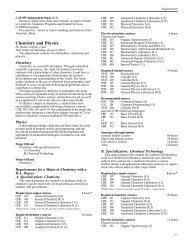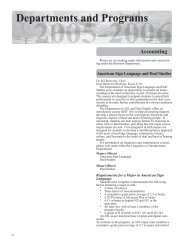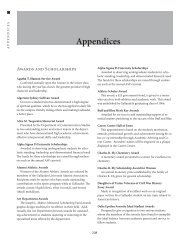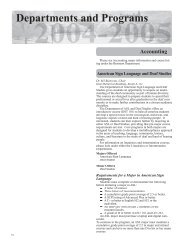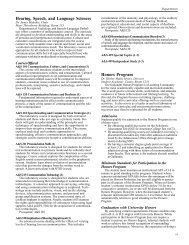catalog 05-06.indd - Undergraduate Admissions - Gallaudet University
catalog 05-06.indd - Undergraduate Admissions - Gallaudet University
catalog 05-06.indd - Undergraduate Admissions - Gallaudet University
Create successful ePaper yourself
Turn your PDF publications into a flip-book with our unique Google optimized e-Paper software.
Academic Informationof his or her academic advisor to improve his or her GPA insucceeding semesters.Whether or not students receive academic progress reportsor academic alerts, it is the right and responsibility ofstudents to seek feedback about their academic performancefrom their faculty and academic advisors.Academic WarningA freshman student is placed on Academic Warning whenthe student’s cumulative GPA falls between 1.75 and 1.99at the end of any semester or summer term. Freshmen onAcademic Warning are required to meet with their academicadvisors to discuss possible modification to their course load,extracurricular activities, and/or employment, and to seektutoring or other academic support to improve performance.Academic ProbationA student is placed on Academic Probation if the student’scumulative GPA is below 2.0 at the end of the semester orsummer term. A freshman is placed on Academic Probationif the cumulative GPA falls below 1.75 for the first time or ifa freshman has been previously placed on Academic Warningand his/her cumulative GPA remains below 2.0 for thesecond time. While on Academic Probation, the student musthave a semester GPA of 2.0 or higher to enroll the followingsemester. The student remains on Academic Probation untilhis or her cumulative GPA improves to 2.0 or above. A studenton Academic Probation whose semester GPA falls below2.0 is automatically suspended. Nevertheless, if a student onAcademic Probation makes a semester GPA of 2.0 or better,but has a cumulative GPA below 2.0, he/she shall remain onAcademic Probation.Students on Academic Probation are required at thebeginning of the semester to meet with their advisors to signacademic contracts designed to improve their scholastic performancein the upcoming semester. The academic contractwill address the following issues:* Course load - students will be required to take amanageable course load. This stipulation may meanlimiting the course load to 12 credit hours.* Academic Support - students will be required todocument participation in academic support activities(tutoring to workshops, for example).* Extracurricular activities - students will not be permittedto participate in extracurricular activities.* Employment - students may be required to limitemployment.Academic SuspensionA student may be academically suspended for either oftwo circumstances:*A student on Academic Probation whose semester GPAfalls below 2.0 is placed on Academic Suspension andis ineligible to enroll in the next semester andsummer term. (For example, a student suspended after aspring semester cannot enroll at the <strong>University</strong> until thefollowing spring semester, at the earliest.)*A student admitted with condition(s) who has notsatisfied the condition(s) and who has not beenrecommended by the Condition Review Committee forcontinued enrollment as a degree-seeking student willbe suspended. That student may re-enroll as a degreeseekingstudent only after satisfying the condition(s).Reporting Unsatisfactory Academic PerformanceAcademic Alert, Academic Warning, Academic Probation,and Academic Suspension appear only on the students’ termgrade reports and unofficial transcripts.Appealing Academic SuspensionDue to compelling and verifiable circumstances such aspersonal, family, medical, psychological, or any other emergencyor special academic consideration, a student subject toAcademic Suspension may request a hearing before CommitteeC (Faculty and Student Affairs). If Committee C sodecides, the student may be permitted to return for an additionalsemester on Academic Probation. Students wishing toappeal to Committee C should contact the Registrar’s Officefor forms and deadlines.Classification of StudentsTwenty-five semester hours of college degree credit (notincluding institutional credits) are required for sophomoreclassification; 56 degree semester hours for junior classification;and 90 degree semester hours for senior classification.Students not planning to work for a degree may be admittedas special students if their objectives are approved by thedean of the college or school to which they are applying.Normal Course LoadEach full-time student is expected to take at least 12 credithours each semester. Special permission of the dean of thecollege or school is necessary for students to register formore than 19 credit hours per semester.The maximum load for regular summer sessions is onethree-credit course and one physical education course persession. However, individual departments may offer coursesduring the summer that do not conform to the regular summersessions. The number of credits for such courses will beestablished on a course-by-course basis.Only full-time students are eligible for dormitory residence.Exceptions to this rule require the signatures from the CampusLife director and the appropriate dean.Course NumbersCourses offered in the <strong>University</strong> are numbered as follows:Below 100 are non-degree courses.100 through 199 are primarily freshman courses.200 through 299 are primarily sophomore courses.300 through 499 are primarily junior and senior courses.500 through 599 are courses designed for both upper divisionundergraduates and graduate students600 through 899 are graduate-level courses.Figures in parentheses following course titles show creditin semester hours.Dual-Listed CoursesDual-listed courses, listed in both undergraduate andgraduate <strong>catalog</strong>s, are defined as courses that have the samecourse descriptions and the same course requirements. Thesecourses are listed 600 through 699 for both undergraduateand graduate students. Dual-listed courses are graduate levelcourses that are open to enrollment by advanced undergraduatelevel students.Cross-Listed CoursesCross-listed courses are defined at two different levels orare defined and listed by two different programs or departments.There are two types of cross-listed courses:* Courses that are listed as a 400-level course inthe <strong>Undergraduate</strong> <strong>catalog</strong> and as a 700-level coursein the Graduate School <strong>catalog</strong>. There may bedifferent course requirements for graduate andundergraduate students.30



